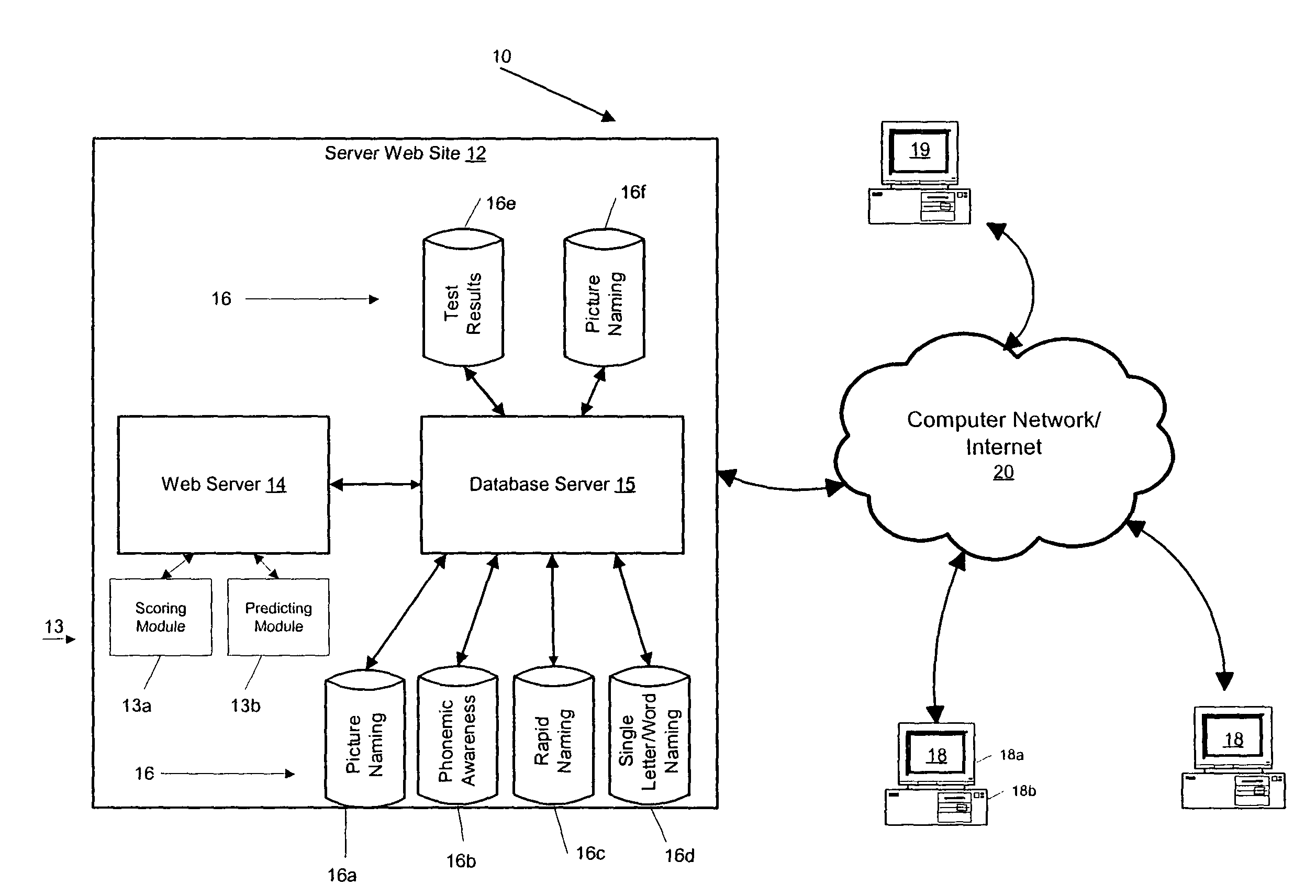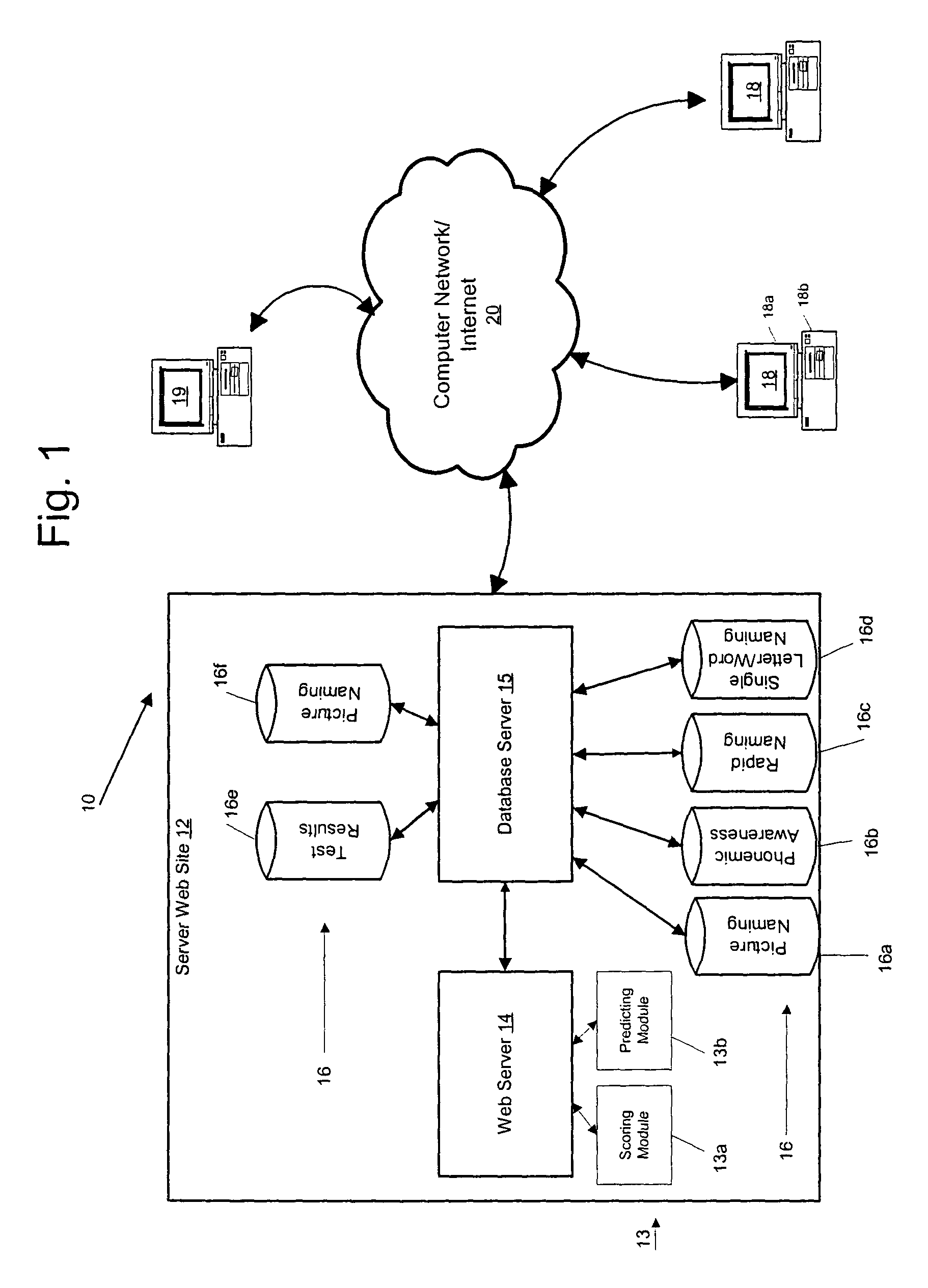Predictive assessment of reading
a reading and reading technology, applied in the field of reading prediction assessment, can solve the problems of low reading score, inconvenient and time-consuming administration of many of these tests, and academic and vocational underachievemen
- Summary
- Abstract
- Description
- Claims
- Application Information
AI Technical Summary
Problems solved by technology
Method used
Image
Examples
example 1
[0082]In one illustrative example according to the present invention, the measurement of picture vocabulary includes a Boston Naming Test, the measurement of phonemic awareness includes a Phonemic Analysis Composite test, the measurement of rapid naming includes a Rapid Automatized Naming Test (letter-number subtest), and the measurement of single letter or word naming includes a Decoding Skills Test-Real Word Subtest. The scores of the tests may be standardized to conform to the I.Q. score standard, i.e., a 100 mean score with a standard deviation of 15. The tests are administered in first grade.
[0083]In Example 1, Equation 1 is used to generate an assessment of concurrent or future reading ability according to the following numeric values for using test results from first grade to predict a Woodcock-Johnson test score in first, third, and eighth grades:
FutureAssessmentScore=y+CPNVPNV+CPAPA+CRNRN+CSLWSLW
where y is 4.160 (first grade); 2.770 (third grade); 2.880 (eighth grade)[0084...
example 2
[0093]In one illustrative example according to the present invention, the measurement of picture vocabulary includes a Peabody Picture Vocabulary test-Revised, the measurement of phonemic awareness includes a Lindamood Auditory Conceptualization test, the measurement of rapid naming includes a Rapid Automatized Naming—Single Color-Object test, and the measurement of single letter or word naming includes a Woodcock Johnson—Letter-Word Identification Test, 1977 version. The scores of the tests may be standardized to conform to the I.Q. score standard, i.e., a 100 mean score with a standard deviation of 15. The tests are administered in first grade.
[0094]In Example 2, Equation 1 is used to generate an assessment of concurrent or future reading ability according to the following numeric values for using test results from first grade to predict a Woodcock-Johnson test score in first, third, and eighth grades:
FutureAssessmentScore=y+CPNVPNV+CPAPA+CRNRN+CSLWSLW
where y is 15.430 (first gra...
example 3
[0104]In an illustrative example according to the invention, the tests in Example 1 and the tests in Example 2 are considered. That is, the measurement of picture vocabulary includes a Boston Naming Test and Peabody Picture Vocabulary test-Revised, the measurement of phonemic awareness includes a Phonemic Analysis Composite test and a Lindamood Auditory Conceptualization test, the measurement of rapid naming includes a Rapid Automatized Naming Test and Rapid Automatized Naming—Single Color-Object test, and the measurement of single letter or word naming includes a Decoding Skills Test-Real Word Subtest and a Woodcock Johnson—LWI. The scores of the tests may be standardized to conform to the I.Q. score standard, i.e., a 100 mean score with a standard deviation of 15. The tests are administered in first grade.
[0105]In Example 1, Equation 1 is used to generate an assessment of concurrent or future reading ability according to the following numeric values for using test results from fir...
PUM
 Login to View More
Login to View More Abstract
Description
Claims
Application Information
 Login to View More
Login to View More - R&D
- Intellectual Property
- Life Sciences
- Materials
- Tech Scout
- Unparalleled Data Quality
- Higher Quality Content
- 60% Fewer Hallucinations
Browse by: Latest US Patents, China's latest patents, Technical Efficacy Thesaurus, Application Domain, Technology Topic, Popular Technical Reports.
© 2025 PatSnap. All rights reserved.Legal|Privacy policy|Modern Slavery Act Transparency Statement|Sitemap|About US| Contact US: help@patsnap.com



